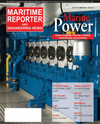
Page 17: of Maritime Reporter Magazine (September 2012)
Marine Propulsion Annual
Read this page in Pdf, Flash or Html5 edition of September 2012 Maritime Reporter Magazine
September 2012www.marinelink.com 17function testing for subsea secondaryblowout preventer (?BOP?) intervention; Requires documentation for BOP in- spections and maintenance;Requires a Registered Professional Engineer to certify casing and cementingrequirements; and Establishes new well control training requirements for deepwater operations. The Final Rule diverges from, updates, or clarifies a number of issues in the IFR in various ways. Of particular note, the Final Rule:Incorporates an updated version API Standard 65, Part 2, which was issued in December 2010 to enhance and describewell control barriers and to define testing requirements for cement to be considereda barrier;Requires the operator to perform a negative pressure test only on wells that use a subsea blowout preventer (?BOP?) stack or wells with a mudline suspensionsystem instead on all wells; Clarifies that dual float valves are not considered sufficient mechanical barri- ers;Requires BOP systems to include a wellhead assembly with a rated working pressure that exceeds the maximum an- ticipated well head pressure; and Extends the requirements for BOPs and well control fluids to well comple-tion, well workover, and decommission- ing operations. The following is a link to the Final Rule: www.gpo.gov/fdsys/pkg/FR- 2012-08-22/pdf/2012-20090.pdf ConclusionsOwners and operators of offshore fa- cilities should review the NTL to ensure OSRP preparation and submissions are inaccordance with the NTL to expedite fu- ture BSEE approvals. In addition, lessees, operators, and contractors shouldreview BSEE regulations applicable to their operations, including the new BSEE Safety and Environmental Management System requirements, in the context of contractor activities that could lead to en- forcement action and the issuance ofINCs and take appropriate action to min- imize the likelihood of any future BSEE enforcement action. Finally, lessees, op- erators, and companies engaged in well control operations should review the Final Rule for new requirements applica- ble to their operations in order to take ap- propriate action to help ensure offshore activities are conducted in accordance with the Final Rule. For 80 years, Gibbs & Cox has provided the worlds most advanced maritime engineering solutions to our Navy and commercial customers. Our teams innovations have helped establish the foundation of cost-effective shipbuilding today. We hire the best naval architects, marine engineers, and CAD designers to engineer the Navys highest priority projects and the next generation of US sea power. Gibbs & Cox is headquartered in Arlington, VA with offices in Hampton, VA; New Orleans, LA; Philadelphia, PA; New York, NY and Washington, D.C. To learn more about how you can build a future with us, visit www.GibbsCox.com/jobs.htm Gibbs & Cox is an equal opportunity employer M/F/D/V. No Agencies please. www.GibbsCox.com Design The Best With The Best Owners and operators of offshore facilities should review the NTL to ensure OSRP preparation and submissions are in accordance with the NTL to expedite future BSEE approvals. MR#9 (10-17):MR Template 9/11/2012 1:27 PM Page 17

 16
16

 18
18
